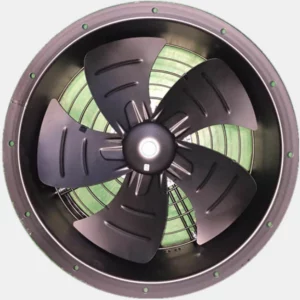A high-efficiency DC (Direct Current) axial fan operates based on the same principles as a standard axial fan but incorporates design features and technologies to improve its efficiency.
Here’s how it works:
- Motor: The fan is powered by a DC motor, which runs on direct current supplied by a power source such as batteries or a DC power supply. DC motors are known for their energy efficiency and precise control.
- Axial Flow: The fan consists of a series of blades or impellers mounted on a central hub. When the motor rotates the blades, they draw air in parallel to the axis of rotation and push it in the same direction. This axial flow creates a continuous airflow.
- Blade Design: High-efficiency axial fans often feature advanced blade designs to optimize airflow and reduce energy consumption. The blades may have aerofoil shapes or incorporate twists and angles to improve aerodynamic performance.
- Variable Speed Control: DC axial fans are equipped with variable speed control mechanisms, allowing the fan’s rotational speed to be adjusted according to the desired airflow and cooling requirements. This flexibility enables energy savings by reducing power consumption when lower airflow is sufficient.
- Electronic Control: High-efficiency DC axial fans may include electronic control features such as pulse width modulation (PWM) or intelligent fan controllers. PWM control adjusts the fan speed by rapidly switching the power supplied to the motor, providing precise speed control and energy savings. Intelligent fan controllers monitor temperature or other parameters and adjust the fan speed accordingly, optimizing cooling while minimizing energy usage.
- Efficiency Enhancements: To further improve efficiency, high-efficiency DC axial fans may incorporate additional features such as optimized airfoil shapes, reduced blade tip clearance, and advanced materials for reduced friction and improved airflow.
The combination of a high-efficiency DC motor, advanced blade design, variable speed control, high efficiency dc axial fan and electronic control mechanisms allows these fans to deliver efficient airflow while minimizing energy consumption. They find applications in various industries, including electronics cooling, ventilation systems, HVAC, and automotive cooling systems, where energy efficiency and precise airflow control are critical.
What are some advantages of using a high-efficiency DC axial fan compared to other types of fans?
Using a high-efficiency DC axial fan offers several advantages compared to other types of fans:
- Energy Efficiency: High-efficiency DC axial fans are designed to minimize energy consumption while delivering the required airflow. The use of efficient DC motors and advanced blade designs helps reduce power usage, resulting in energy savings over time. This can be particularly beneficial in applications where fans operate continuously or for extended periods.
- Variable Speed Control: DC axial fans can be easily controlled to vary their rotational speed. By adjusting the fan speed based on cooling requirements, energy can be optimized. This flexibility allows for precise airflow control, reducing energy waste when lower airflow is sufficient.
- Lower Noise Levels: High-efficiency DC axial fans often incorporate noise-reducing design features and technologies. The use of advanced blade designs, improved motor control, and quieter operation contribute to lower noise levels. This makes them suitable for applications where noise reduction is important, such as in electronic devices or quiet environments.
- Compact Size: DC axial fans are typically compact in size, making them suitable for applications where space is limited. Their compact design allows for easy integration into various devices and systems without occupying excessive space.
- Long Lifespan: High-quality DC axial fans are built to be durable and reliable. The use of efficient and well-designed components, along with proper maintenance, can result in a long operational lifespan. This reduces the need for frequent replacements and associated costs.
- Environmental Friendliness: DC axial fans consume less energy compared to other types of fans, resulting in a reduced carbon footprint. Additionally, since they are powered by DC motors, they can be integrated with renewable energy sources such as solar panels or batteries, further promoting sustainability.
- Precise Control and Monitoring: DC axial fans can be equipped with intelligent fan controllers that allow for precise control and monitoring of fan speed, temperature, and other parameters. This enables optimized cooling and system performance while providing real-time feedback and diagnostics.
It’s important to note that the suitability of a high-efficiency DC axial fan depends on the specific application requirements and operating conditions. Consulting with experts or suppliers can help determine the most appropriate fan type for a particular application.
